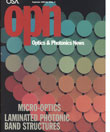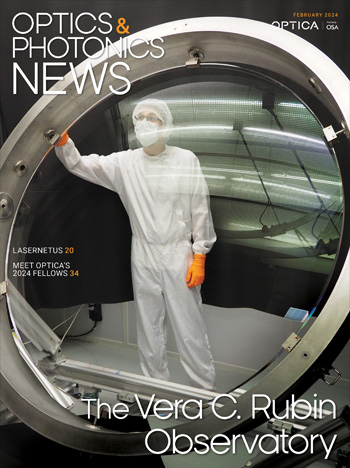
September 1999 Issue
- Micro-Optics Plenty of Room at the Bottom
- Laminated Photonic Band Structures with High Conductivity and High Transparency: Metals Under a New Light
- OSA Instrumental in Development of the Uniform Color Scales
- Nomarski's Differential Interference Contrast Microscope
- Fast Double-Gauss Lens
- Browse all Issues
Feature Articles
Micro-Optics Plenty of Room at the Bottom
Fabrication technologies compete as well as complement each other in the smallest of small optics.
by Yvonne Carts-PowellLaminated Photonic Band Structures with High Conductivity and High Transparency: Metals Under a New Light
The development of a new transparent conductor is based on one-dimensional metal-dielectric photonic band gap structures. Thin-film metal-dielectric filters containing at least 150 nm of silver have been fabricated, with transmittance greater than 50% over the 500-600 nm waveband, and sheet resistance of ~ 0.1 Ω/Square. Theoretical calculations predict 25% transparency levels for structures that contain ~ 1 μm of silver, and transparencies that approach 80% for structures that have in excess of 100 nm of silver. Some applications for transparent, conducting films include antennas embedded in windshields, electrodes on flat panel displays, electromagnetic shielding, and solar window panes, to name a few.
by Michael Scalora, Mark J. Bloemer, Charles M. BowdenOSA Instrumental in Development of the Uniform Color Scales
A perceptually uniform color space was important to both industry and the arts. Among other advantages, industrial color tolerances could be established more easily in a uniform color space. Studies leading to improvement of the uniformity of the Munsell color system had been completed a few years earlier. Judd, Blanche Bellamy, Sidney M. Newhall, Dorothy Nickerson, Carl Foss and Walter Granville, with others, had published supporting papers in the Journal of the Optical Society of America in 1943. These individuals knew that although the renotation had improved spacing, the Munsell color system is based on radiating polar coordinates and can never be completely uniform. Furthermore, all color systems at that time included additional concepts that could not coexist with uniformity. Sometimes complementary colors, either additive or subtractive, must fall opposite one another, or a trio of primary colors must be evenly placed around the color wheel.
by Joy Turner LukeNomarski's Differential Interference Contrast Microscope
The Nomarski microscope uses a Wollaston prism in the illumination path to produce two orthogonally polarized, slightly shifted bright spots at the sample's surface. Upon reflection from (or transmission through) the sample, the two beams are collected by the objective lens, then sent through the same (or, in the case of a transmission microscope, a similar) Wollaston prism, which recombines the two beams by sliding them back over each other. The two beams subsequently arrive coincidentally in the image plane of the microscope, but the two images of the sample, which they carry, will be relatively displaced. A linear analyzer, placed after the Wollaston prism in the reflected (transmitted) path, brings the polarization vectors of the two images into alignment, enabling the two to interfere with each other. A sheared interferogram of the sample's surface is thus formed at the image plane of the microscope.
by Masud MansuripurFast Double-Gauss Lens
The double-Gauss form is one of the most common lens design types, and it appears in more than 400 U.S. patents alone. One of the most desirable aspects of the double-Gauss is its ability to be well corrected at a very high aperture over a moderately large field of view. It is possible to design reasonably high performance double-Gauss lenses having a numerical aperture greater than 0.5 (f/# less than 1.0), but such ultra-high aperture designs are still fairly exotic and appear in fewer than 20 U.S. patents.
by J. Brian Caldwell
![A multiplexed image of a human tonsil acquired. [NIAID] using the iterative bleaching extends multiplexity (IBEX) method.](https://opnmedia.blob.core.windows.net/$web/opn/media/images/articles/2024/0424/departments/202404-cover-web.jpg?ext=.jpg)

